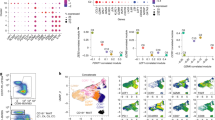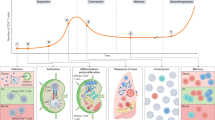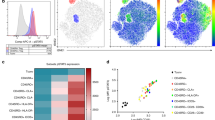Abstract
The T cell compartment is phenotypically and functionally heterogeneous; subsets of naive and memory cells have different functional properties, and also differ with respect to homeostatic potential and the ability to persist in vivo. Human stem cell memory T (TSCM) cells, which possess superior immune reconstitution and antitumor response capabilities, can be identified by polychromatic flow cytometry on the basis of the simultaneous expression of several naive markers together with the memory marker CD95. We describe here a protocol based on the minimum set of markers required for optimal identification of human and nonhuman primate (NHP) TSCM cells with commonly available flow cytometers. By using flow sorters, TSCM cells can thereby be isolated efficiently at high yield and purity. With the use of the 5.5-h isolation procedure, depending on the number of cells needed, the sorting procedure can last for 2–15 h. We also indicate multiple strategies for their efficient expansion in vitro at consistent numbers for functional characterization or adoptive transfer experiments.
This is a preview of subscription content, access via your institution
Access options
Subscribe to this journal
Receive 12 print issues and online access
$259.00 per year
only $21.58 per issue
Buy this article
- Purchase on SpringerLink
- Instant access to full article PDF
Prices may be subject to local taxes which are calculated during checkout





Similar content being viewed by others
References
Perfetto, S.P., Chattopadhyay, P.K. & Roederer, M. Seventeen-colour flow cytometry: unravelling the immune system. Nat. Rev. Immunol. 4, 648–655 (2004).
Lugli, E., Troiano, L. & Cossarizza, A. Investigating T cells by polychromatic flow cytometry. Methods Mol. Biol. 514, 47–63 (2009).
Sallusto, F., Lenig, D., Forster, R., Lipp, M. & Lanzavecchia, A. Two subsets of memory T lymphocytes with distinct homing potentials and effector functions. Nature 401, 708–712 (1999).
Gattinoni, L. et al. A human memory T cell subset with stem cell-like properties. Nat. Med. 17, 1290–1297 (2011).
Zhang, Y., Joe, G., Hexner, E., Zhu, J. & Emerson, S.G. Host-reactive CD8+ memory stem cells in graft-versus-host disease. Nat. Med. 11, 1299–1305 (2005).
Gattinoni, L. et al. Wnt signaling arrests effector T cell differentiation and generates CD8+ memory stem cells. Nat. Med. 15, 808–813 (2009).
Pitcher, C.J. et al. Development and homeostasis of T cell memory in rhesus macaque. J. Immunol. 168, 29–43 (2002).
De Rosa, S.C., Herzenberg, L.A. & Roederer, M. 11-color, 13-parameter flow cytometry: identification of human naive T cells by phenotype, function, and T-cell receptor diversity. Nat. Med. 7, 245–248 (2001).
Mahnke, Y.D. & Roederer, M. Optimizing a multicolor immunophenotyping assay. Clin. Lab. Med. 27, 469–485 (2007).
Schmitz, I. et al. An IL-2-dependent switch between CD95 signaling pathways sensitizes primary human T cells toward CD95-mediated activation-induced cell death. J. Immunol. 171, 2930–2936 (2003).
Lugli, E. et al. Quercetin inhibits lymphocyte activation and proliferation without inducing apoptosis in peripheral mononuclear cells. Leuk. Res. 33, 140–150 (2009).
Lugli, E. et al. Transient and persistent effects of IL15 on lymphocyte homeostasis in nonhuman primates. Blood 116, 3238–3248 (2010).
Geginat, J., Sallusto, F. & Lanzavecchia, A. Cytokine-driven proliferation and differentiation of human naive, central memory, and effector memory CD4+ T cells. J. Exp. Med. 194, 1711–1719 (2001).
Geginat, J., Lanzavecchia, A. & Sallusto, F. Proliferation and differentiation potential of human CD8+ memory T cell subsets in response to antigen or homeostatic cytokines. Blood 101, 4260–4266 (2003).
Gattinoni, L. et al. Acquisition of full effector function in vitro paradoxically impairs the in vivo antitumor efficacy of adoptively transferred CD8+ T cells. J. Clin. Invest. 115, 1616–1626 (2005).
Perfetto, S.P., Ambrozak, D., Nguyen, R., Chattopadhyay, P. & Roederer, M. Quality assurance for polychromatic flow cytometry using a suite of calibration beads. Nat. Protoc. 1, 1522–1530 (2006).
Roederer, M. Spectral compensation for flow cytometry: visualization artifacts, limitations, and caveats. Cytometry 45, 194–205 (2001).
Kantor, A.B. & Roederer, M. FACS analysis of lymphocytes. in Handbook of Experimental Immunology, Vol. 49 (eds. Herzenberg, L.A., Weir, D.M., Herzenberg, L.A. & Blackwell, C.) 1–13 (Blackwell Science, 1997).
English, D. & Andersen, B.R. Single-step separation of red blood cells. Granulocytes and mononuclear leukocytes on discontinuous density gradients of Ficoll-Hypaque. J. Immunol. Methods 5, 249–252 (1974).
Altman, J.D. et al. Phenotypic analysis of antigen-specific T lymphocytes. Science 274, 94–96 (1996).
Cavalieri, S. et al. Human T lymphocytes transduced by lentiviral vectors in the absence of TCR activation maintain an intact immune competence. Blood 102, 497–505 (2003).
Surh, C.D. & Sprent, J. Homeostasis of naive and memory T cells. Immunity 29, 848–862 (2008).
Acknowledgements
We thank J. Yu and M. Beddall (ImmunoTechnology Section, VRC) for antibody conjugation; S.P. Perfetto, D. Ambrozak and R. Nguyen (Flow Cytometry Core, VRC) for assistance with cell sorting; M. F. Quigley (Immunology Laboratory, VRC) for providing the HLA-A*0201+ donor; and the other members of the ImmunoTechnology section for continuous discussion. This work was supported by the NIH Intramural Research Program and by the Associazione Italiana per la Ricerca sul Cancro to E.L.
Author information
Authors and Affiliations
Contributions
E.L. conceived the protocol; E.L., L.G. and A.R. performed the experiments; D.A.P. and D.M. provided reagents and critical support; N.P.R. and M.R. supervised the research; L.G., D.M., D.A.P. and N.P.R. edited the manuscript; E.L. and M.R. wrote the manuscript.
Corresponding authors
Ethics declarations
Competing interests
The authors declare no competing financial interests.
Rights and permissions
About this article
Cite this article
Lugli, E., Gattinoni, L., Roberto, A. et al. Identification, isolation and in vitro expansion of human and nonhuman primate T stem cell memory cells. Nat Protoc 8, 33–42 (2013). https://doi.org/10.1038/nprot.2012.143
Published:
Issue Date:
DOI: https://doi.org/10.1038/nprot.2012.143



